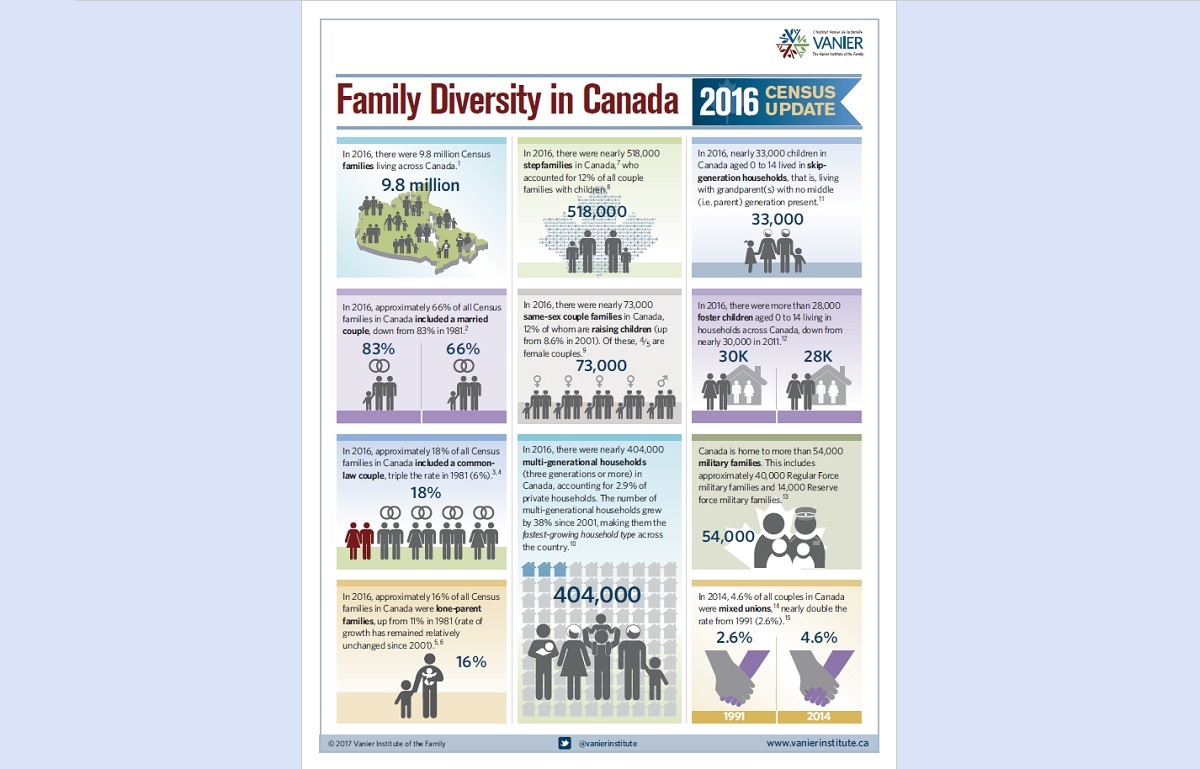
October 31, 2017
Infographic: Family Diversity in Canada (2016 Census Update)
Download the Family Diversity in Canada (2016 Census Update) infographic
The Vanier Institute of the Family has now been exploring families and family life in Canada for more than 50 years. Throughout this half-century of studying, discussing and engaging with families from coast to coast to coast, one thing has been clear from the outset: families in Canada are as diverse as the people who comprise them.
This has always been the case, whether one examines family structures, family identities, family living arrangements, family lifestyles, family experiences or whether one looks at the individual traits of family members such as their ethnocultural background, immigration status, sexual orientation or their diverse abilities.
These parents, children, grandparents, great-grandparents, aunts, uncles, siblings, cousins, friends and neighbours all make unique and valuable contributions to our lives, our workplaces and our communities. As former Governor General of Canada, His Excellency The Right Honourable David Johnston, said at the Families in Canada Conference 2015, “Families, no matter their background or their makeup, bring new and special patterns to our diverse Canadian tapestry.”
Using new data from the 2016 Census, the Vanier Institute has published an infographic on family diversity in Canada.
Highlights include:
- 66% of families in Canada include a married couple, 18% are living common-law, and 16% are lone-parent families – diverse family structures that continuously evolve.
- 518,000 stepfamilies live across the country, accounting for 12% of couples with children under age 25.
- 404,000 households in Canada are multi-generational,1 and nearly 33,000 children live in skip-generation households.2
- 1.7M people in Canada reported having an Aboriginal identity (58.4% First Nations, 35.1% Métis, 3.9% Inuit, 1.4% other Aboriginal identity, 1.3% more than one Aboriginal identity).
- 360,000 couples in Canada are mixed unions,3 accounting for 4.6% of all married and common-law couples.
- 73,000 same-sex couples were counted in the 2016 Census, 12% of whom are raising children.
- 54,000 military families live in Canada, including 40,000 Regular Force military families and 14,000 Reserve force military families.
Download the Family Diversity in Canada (2016 Census Update) infographic.
This bilingual resource is a perpetual publication, and will be updated periodically as new data emerges (older versions are available upon request). Sign up for our monthly e-newsletter to find out about updates, as well as other news about publications, projects and initiatives from the Vanier Institute.
Notes
- Containing three or more generations.
- Living with grandparent(s) with no middle (i.e. parent) generation present.
- Statistics Canada defines a mixed union as “a couple in which one spouse or partner belongs to a visible minority group and the other does not, as well as a couple in which the two spouses or partners belong to different visible minority groups.” Link: http://bit.ly/2tZvrSr.
Stay in the know
InfoVanier
A monthly newsletter of research, resources, and events
Linktree
Get alerts on new Vanier Institute publications, events, and announcements
